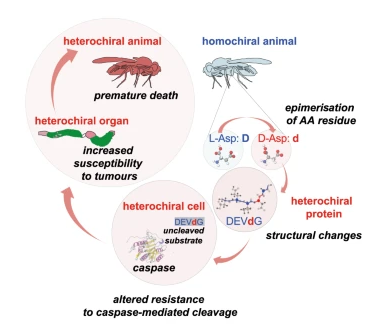Dr Shayon Bhattacharya and Prof Damien Thompson have published in the world-leading Nature Communications journal. Their paper on the “Biological effects of the loss of homochirality in a multicellular organism” derives from an SSPC modelling theme collaboration with the Institut de Biologie Valrose (iBV) in Nice, France.
Amino acids in proteins are maintained in one specific L-chiral form in the body. D-amino acids are not normally incorporated into proteins and their accumulation has been associated with several conditions including schizophrenia, amyotrophic lateral sclerosis, and other age-related neurodegeneration. In this research, chiral-selective in vivo assays were used to detect protein-bound non-L-α-amino acids (focusing on aspartate) and assess their functional significance in Drosophila. The importance of this chiral discriminating capacity detected caspase-bound D-Asp in Drosophila where altering the chiral balance created impaired caspase activity and impaired apoptosis, increasing tumour formation, and leading to premature death.
To further confirm the mechanisms by which the accumulation of D-amino-acids in proteins may lead to the observed pathophysiological consequences, a model protease system, caspase-3 that specifically hydrolyses the 4’–5’ peptide bond of the pentapeptide substrate DEVDG, was studied. The developed models reveal that caspase-3 naturally rejects the pentapeptide containing D-Asp substrate, DEVdG and prevents catalytic activity by caspase. The modelling data further corroborates that the molecular level charge balancing that enforces the chiral recognition is necessary to maintain homeostasis across the cell, tissue, and organ level including the prevention of neurodegenerative diseases.
The supporting paper is available here: https://rdcu.be/cZ3eh
